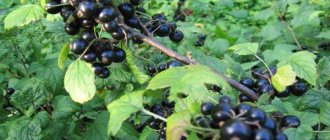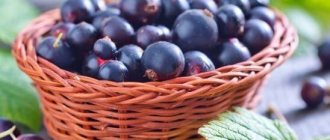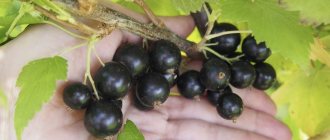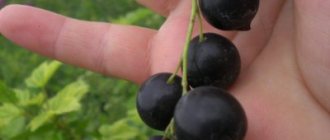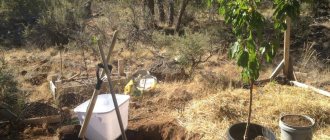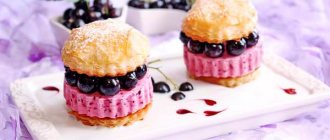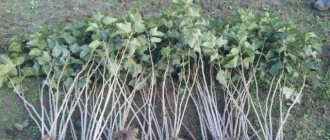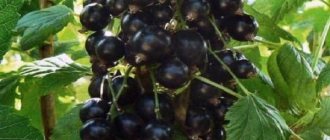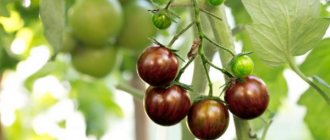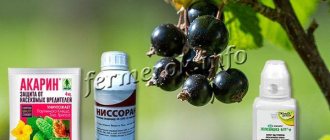History of selection of currant Izyumnaya
In the second half of the 20th century, American powdery mildew from gooseberries affected black currants. The spheroteka spread throughout Europe, and then Russia. To combat this scourge, research began. Scientists have concluded that inbreeding of samples increases disease resistance in donor varieties. At the same time, new sources of immunity are identified.
Thus, from the family of Goliath and Seedling Black, selection number 12-173 appeared - a source of immunity against powdery mildew (spheroteca). With the participation of this number, a complex hybrid of 37-5 and the Golubka Seedling was created - the Izyumnaya variety. The author is the outstanding Soviet and Russian scientist A. I. Astakhov (1931-2007).
Landing algorithm
To get a high-quality and large harvest of healthy berries, you need to follow the rules of planting and caring for the fruit crop.
Optimal timing
In southern and temperate climates, it is recommended to plant currant seedlings in open ground in the fall, 4-6 weeks before the first frost. In this case, the bushes will take root and begin to bear fruit in the summer. In regions with cold winters, the planting of currant bushes is postponed to the spring.
Site selection and preparation
For planting berry crops, choose sunny, level, dry plots of land that are protected from drafts. Also, groundwater must be at least 1.5-2 m from the ground surface. Work on soil preparation begins 3-4 weeks before planting the seedlings.
- The selected area is carefully dug up, cleared of weeds and loosened.
- The soil is mixed with humus, mineral and organic fertilizers.
- Lime or wood ash is added to soil with a high acid content.
- Clayey, heavy soil is mixed with sand and humus.
- If sandy soils predominate on the site, then river sand and peat are added to it.
Important! Hybrid currant bushes are not recommended to be planted in lowlands and wetlands. High humidity causes the rhizome to rot and the plant to die.
Preparing the beds and planting hole
When choosing seedlings, first of all, pay attention to the integrity and health of the roots. Rhizomes should not be broken, overdried or damaged. Any growths, formations, putrefactive and fungal manifestations are not acceptable.
- Planting holes are dug in a prepared area with fertile soil.
- The depth and width of the holes is from 45 to 50 cm.
- The distance between plantings is from 80 cm to 1 m, between rows is 1.5 m.
- A drainage layer of broken stone or crushed stone is laid at the bottom of the hole.
- Next, fertile soil is poured in the shape of a small mound.
When preparing planting holes, it is necessary to take into account the size of adult plants. The more ventilation the berry bushes have, the lower the risk of developing fungal and viral infections.
Landing technology
Before planting in open ground, the roots of the seedling are soaked in warm, settled water and treated with antibacterial agents.
- The seedling is placed on the top of the mound at a slight slope.
- The roots are evenly distributed in the hole and carefully covered with fertile soil, trying not to leave any voids between the roots and the soil.
- The soil under the bush is compacted and watered.
After planting, the tree trunk circle is mulched with peat mixed with sawdust or straw.
Advantages and disadvantages of the variety
The Izyumnaya blackcurrant variety is endowed with both positive and negative qualities.
Advantages:
- drought- and frost-resistant;
- resistant to bud mite and powdery mildew;
- resistant to air temperature changes;
- does not crumble until autumn;
- easy to care for;
- dessert fruits, honey-sweet.
Flaws:
- poorly resists septoria;
- Difficult to propagate from tree cuttings.
Is this my Raisin blackcurrant sick or affected by glassware?
What is this that has formed here on the shoots of black currants? They are mostly curved, although when cutting off, I did not find any traces of damage from glassware.
The buds have swollen and are about to open - the weather is reminiscent of early spring.
My beauty grows in soil that is close to neutral in acidity, despite the lowest position in the garden, it is only flooded during heavy rains. All summer it grew actively, developed, and bore fruit for the first time.
Periodically affected by aphids. Treatment was carried out regularly with Fitoverm and a strong concentration of tobacco dust infusion.
Planted in spring 2014. The soil is sandy loam with the addition of rotted sawdust and vermicompost. What to do? Transplant?
Elena Your currants are affected by shoot aphids. Currants were not treated for aphids immediately when aphids appeared, but when you had time, or when the aphids had already multiplied and began to damage in colonies. When the aphids sucked the juices from the shoots, they became distorted, and when you destroyed the aphids, they tried to grow normally again. But aphids produce four to five generations over the summer, the next generation began to damage again and the shoots became bent again. Conclusion: it is necessary to treat bushes against aphids as soon as their presence is detected. You should start observing the development of currants in the spring, as soon as the leaves appear. Aphids can be fought with decoctions and infusions of insecticidal plants: dandelion, yarrow, tobacco, horse sorrel and others.
Dandelion - an infusion of leaves, or leaves with roots, is used against aphids, mites and honey bees. 400 g of crushed leaves and roots are infused in 10 liters of warm water for 2-3 hours, filtered and immediately used for spraying. The first spraying is carried out on the opening buds. Tomatoes - 4 kg of chopped tops (stepchildren can be used) are poured with 10 liters of water, boiled for half an hour, left for another 3-4 hours and filtered. To prepare the working solution, 3 liters of decoction are diluted with water to 10 liters. Used against aphids and young caterpillars of pests. S a v e l konskiy - to prepare the infusion, take 300 g of roots or 400 g of leaves (or 350 g of the mixture), pour 10 liters of warm water. Leave for 3-4 hours, filter and spray the plants. Used against aphids and ticks. Potatoes - an infusion of green tops is used against aphids, mites, cabbage whites, and moths. 1.2 - 1.3 kg of green tops (or 0.6 - 0.7 kg dry) are infused in 10 liters of warm water for 3-4 hours, filtered and sprayed. Garlic - 100 g of heads are grated and poured into 1 liter of water, precipitated, squeezed and once again poured with 1 liter of water and squeezed. The liquids are mixed together and stored in a tightly sealed glass container. To prepare the working solution, 300 g of extract is diluted to 10 liters. Effective against aphids, mites and young caterpillars. Pure big - (the plant is poisonous!) 1 kg of crushed plants is poured into 10 liters of hot water, left for two days, filtered and sprayed. Used against aphids, mites and young caterpillars. Tall marigolds are beautifully blooming garden flowers with a pleasant scent. An infusion of plants cut during flowering is used to combat aphids. 500-600 g of dry plants (or 1-1.2 kg of fresh) are poured with 10 liters of water, left for 2 days, filtered and used for spraying. Thou sh e l i s t n i k - an infusion or decoction of plants is used against aphids, mites, bedbugs and small caterpillars. 800 g of dry crushed plants (or 1.5 - 1.7 kg of fresh) are poured with 2-3 liters of boiling water. Leave for 1.5-2.0 days. Before use, filter, add up to 10 liters and spray. To prepare the decoction, take the same quantities of plants and boil for 30 minutes. Tobacco or tobacco - makhorka - an infusion of dry leaves is used against a whole range of pests: aphids, copperheads, thrips, caterpillars, moths on berry and fruit trees, larvae on onions and others. To prepare the infusion, 400 g of dry leaves are infused for 2 days in 10 liters of water in a dark place. Before spraying, filter and dilute with water 1:2. Before spraying, it is advisable to add 40 g of laundry soap or 20-25 g of washing powder to all decoctions and infusions. This improves the adhesion of the liquid to the leaves, which is very important when spraying against aphids, when the main effect is to wet the underside of the leaves, where their clusters are located.
Description and characteristics
Black currant has always been a popular berry in Europe and Russia.
Appearance of the bush
The currant bush is neat, upright, and in its mature stage reaches a height of no more than one and a half meters. The crown consists of branches of different ages. Mostly fresh growth bears fruit.
The leaves are entire, alternate, graceful three-lobed, edged with teeth. The surface is rough and even green in color. On the reverse side of the leaf there are glands that create an extraordinary currant aroma when the leaf is rubbed on the fingers. The currant roots have a fibrous structure and reach a depth of 35 cm.
Flowers and fruits
The five-petalled ovaries (up to 11 pieces) of the Izyumnaya currant, when blooming, create a fragrant cluster of flowers of a pale yellow hue. Flowering is early - in the first third of May. Under unfavorable weather conditions or improper care, unpollinated ovaries fall off.
The fruits are round, large, black, without shine. If good care and favorable weather conditions coincide, they reach a weight of 3.3 g. They ripen almost simultaneously and do not fall off for a long time. The berries taste sweet, honey-sweet, with an amazing currant aroma.
Productivity and fruiting
The genetically declared large-fruitedness of the Izyumnaya currant manifests itself only if the mandatory agrotechnical growing conditions are observed during setting and flowering.
The berries become noticeably smaller as the branches age and differ in size in different soil and climatic zones.
Also, the number of berries in a bunch depends on various factors:
- level of self-pollination;
- the presence of bushes of a different variety in the environment;
- weather conditions before and after flowering, when due to drought or heat some of the ovaries fall off.
Currants bear fruit for up to 15 years. In good years (usually the sixth year), up to 2.5 kg can be removed from the bush. On an industrial scale, the average yield is 11.2 t/ha (1.71 kg/bush), the maximum is 13.6 t/ha (2.0 kg/bush).
See also
Description of the blackcurrant variety Exotic, planting and careRead
Where are raisin currants used?
Currants are consumed in their natural form; they are also good as raisins, not immediately picked from the branches. At home, fruit drinks, juices, jelly desserts, marmalades, tinctures, liqueurs are prepared. To preserve its beneficial properties until the next season, currants are frozen, dried, and preserved using gentle methods.
This is a powerful antiscorbutic, antipyretic and appetite stimulant. Black currant supports the immune system, delays aging, and helps in the treatment of heart disease, skin diseases, and diabetes.
On an industrial scale, high-quality fillings for confectionery products, syrups, extracts, wines, liqueurs, and dry jelly are produced on its basis. In the vitamin industry, raisin currants are used in the production of vitamin C concentrates and preparations.
Drought and frost resistance
Black currant Raisin is drought-resistant and is successfully grown in arid areas. It easily survives frosts down to – 39 C. The flowering and fruiting temperature of this variety is 20-25 C.
Susceptibility to diseases and pests
Not afraid of bud mites and powdery mildew. The least of the studied analogues resists septoria. Pests have to be dealt with in a general manner.
Diseases and pests
The plant is susceptible to pests and diseases. For control we use all types of fungicides and insecticides of contact or systemic action. At an early stage, you can use solutions of folk recipes; such protection can easily cope with gall aphids, scale insects, powdery mildew and other “troubles.” You can get more detailed information in the “Currant” section; here you can find the calendar of treatments, compositions and preparations, and the timing of treatments.
Read about the treatment of currants with Bordeaux mixture in the spring here.
To prepare the solution, we take only warm water, in which the drugs dissolve more easily. You can avoid being affected by a number of diseases and pests. To do this, it is enough to keep the soil under the bushes clean, moist, but not wet, and promptly remove shoots and foliage from the site and perform seasonal digging of the soil.
Landing Features
Timing of planting work
It is best to plant black currants of the Izyumnaya variety in the fall: in the north of the country - in the third ten days of September, in the southern regions - in October and November. The bush will take root before frost, and in the spring it will already receive the necessary nutrition.
In the spring - as the soil condition allows and before the buds open, there will be little time - the plant should have minimal time to take root before the growing season.
Deciding on a place
The most suitable soil for Izyumnaya currants is loose sandy loam or loam. Swampiness and high soil humidity are unacceptable. In acidic soil, the berries become smaller and the harvest is not satisfactory. The place for planting currants is chosen to be sunny, well-lit, usually along a fence or path.
Ventilated areas are excluded. Northern and north-eastern winds are especially destructive.
Preparing the beds and plot
The beds must be built observing the above conditions. Places for planting seedlings should be prepared in advance.
When planting Izyumnaya currants at a distance of up to 2 m between the bushes, the berries will become larger in size and will surprise you with their aroma. The taste of currants will be sweeter, and the harvest will be higher; accordingly, the bushes will delight with harvests longer.
- If the soil is fertilized, superphosphate, wood ash and urea mixed with soil are added to the hole in a ratio of approximately 200:350:45.
- We treat the depleted soil in advance, digging it deeply with the addition of manure, ash and potassium-phosphorus fertilizer.
Selection of seedlings
It is necessary to critically evaluate the condition of the plant:
- there should be no traces of mechanical damage or rot on the roots;
- shoots – not damaged by pests, healthy, flexible;
- the foliage is elastic, without spots and other possible signs of disease.
Sapling planting technology
Guide to action:
- prepare recesses with sides about 50 cm with a distance from each other of at least 1.5-1.8 m;
- add a mixture of superphosphate and humus to the loose soil at the bottom of the hole;
- cover with 10 cm of soil;
- Place the currant roots, pre-soaked for about 4 hours, at an angle of 45 degrees into the recess and straighten them;
- fill the roots and root collar of the seedling with soil 7-8 cm;
- lightly trample the soil around the trunk, water and mulch;
- In the spring, additionally trim the branches to 3-4 buds and water the seedling as needed.
Reproduction of the Raisin bush
Experienced gardeners recommend the method of propagating Raisin currants by regrown cuttings to amateur gardeners. To do this, just press the currant twig to the ground with a hairpin and fall asleep. When the cuttings take root, the cuttings and roots are cut off and planted.
You can propagate Raisin currants by dividing the mother bush.
Selection and preparation of planting material
You need to carefully select seedlings for planting so that they are healthy and strong. The main signs of a good seedling:
- the root system must be healthy and without damage, and there must be no signs of rot or mold;
- healthy and flexible shoots;
- leaves without signs of diseases or spots.
The seedling should have leaves, so you can monitor its health.
Landing algorithm
To plant, you need to dig a hole. The soil from it should be mixed with wood ash, urea and superphosphate. The depth of the hole should be 50 cm, and its diameter should be slightly larger than the root system of the seedling. The bush should feel free.
Landing algorithm:
- Place crushed stone drainage into the hole.
- Place the seedling in the center of the hole and straighten the root system.
- Gently sprinkle the soil in small parts so as not to damage the roots and shoots.
- Compact the soil a little and pour 2.5 buckets of water into the hole.
- Mulch the bush with peat in a layer of 5 cm.
If the shrub is planted correctly, then with minimal care it can produce a good harvest.
Organization of competent care
Irrigation and fertilization
Currant Raisin is drought-resistant. But for a good, large harvest, the soil must be moistened abundantly. It is preferable to water in the evenings. Then - mulching. The crowns of the bushes themselves, due to the lack of rain, need irrigation twice a week.
See also
Description and characteristics of currant variety Treasure, cultivation and careRead
Experienced gardeners know the secret to getting large berries: water the bushes generously in the spring, but be even more careful when the buds are swelling. They need increased humidity in the air at this time. Using a hose with a divider, you will solve this problem easily, and the currants will gratefully respond to care at the end of the season.
Immediately after planting, young bushes do not need fertilizing, but later in the spring, 45 g of urea will significantly affect the yield.
During the period of active fruiting, currants need feeding: when setting berries - a good bucket of solution, complex, mineral fertilizer for a large bush. After harvesting, you should feed the plants with superphosphate and a glass of ash.
Experts recommend covering the bushes with humus at least once every 2 years, followed by adding soil.
Loosening the soil
The Izyumnaya currant variety, like any garden crop, requires loose soil. It must be maintained throughout the season. It is important not to damage the roots close to the surface by loosening. Loosening is not needed if the tree trunk circle is lined with mulch.
Bush formation
- The general rule for forming a bush is to leave 3 new shoots every year, cutting off 2 buds from each.
- In the first season, young shoots are pruned to 3 buds.
- In the following years, each of the remaining 3 young shoots is shortened by 2 buds.
- In addition, in the 3rd and 4th seasons, last year's branches are cut back by 10 cm to stimulate branches.
- Branches five years old and older are pruned close to the trunk.
- Then, every year, the old ones are cut out, leaving the same number of young ones.
- After 10 years, the bush is divided and replanted.
- A good mature currant bush should have 10-15 strong main branches of different ages.
Shelter for the winter
Raisin currants practically do not require shelter, only in case of frosts over 39˚C or:
- young bush up to 2 years old;
- recovered from an illness or dropped its leaves early;
- in anticipation of a snowless or very frosty winter.
Preventative treatments
To prevent diseases and pests in the garden, the following is required:
- timely pruning to prevent thickening of branches;
- burning cut damaged branches;
- digging up row spacing in late autumn to destroy pests that have prepared for winter;
- Early spring treatment of each branch with boiling water before flowering.
You can collect more onion and garlic peels in winter and scatter them under currant bushes in the spring: they will not be afraid of many common misfortunes.
Why don't currants bear fruit?
- Not enough sun.
- Acidic soil.
- There is not enough moisture during the budding period.
- Reversion is a disease in which fruiting stops.
- The butterfly is a glass glass.
- Wood ants eat away the inside of the flower, leaving empty sepals.
- Soil salinity, even the slightest.
- Excess fertilizer.
- Grows in thickets of garden trees.
Agricultural technology
Agrotechnical processes come down to proper planting, care (watering, fertilizing), pruning and shaping the bush, combating attacks of diseases and pests, as well as preparing for winter.
Important! The productivity of the Raisin variety can be attributed to both advantages and disadvantages. The fact is that yield indicators directly depend on weather conditions: if rainy weather with high air humidity persists for a long time, then the yield can rapidly decrease.
Choosing a place and landing
The first thing that anyone who wants to grow the Raisin variety of currants on their plot must decide on is the correct choice of planting site, taking into account criteria such as humidity and lighting.
When choosing a seat, be guided by the following requirements of a given crop:
- good lighting: currants will not grow well in shaded conditions. For effective productivity and life, it needs sunlight. You can plant bushes along fences or paths;
- looseness, lightness and fertility of the soil;
- moderate humidity: choose a site on a slight rise or slope. The selection hybrid does not welcome close groundwater, as well as swampy or overly moist conditions: its root system will rot, which will entail the death of the entire bush;
- soil acidity: the crop prefers soils with a neutral pH level (6.0–6.5);
- protection from drafts and winds. Gardeners have come to the conclusion that the variety does not welcome windy areas, especially if the winds blow from the north or northeast.
As for planting time, it can be done both in spring and autumn. However, it is preferable to carry out planting of the Raisin variety in the autumn, since the young plant will spend time and energy on rooting not during the productive period, but during the cold season. The optimal time for autumn planting is early to mid-October: it must be calculated so that the crop has time to take root before the onset of frost. In spring, the Raisin varietal form is planted in early April, before the buds open.
Important! If planting procedures are carried out in the autumn, the seedlings are hilled up and not pruned. Spring planting should be accompanied by pruning of branches: it is necessary to leave 3
–
4 buds without hilling.
The landing procedure consists of the following steps:
- Digging planting holes with parameters 50x50x50.
- Mixing the soil removed from the pits with fertilizers: compost (1 bucket), superphosphate (200 g), ash (400 g) or potassium sulfate (70 g), limestone (200 g).
- Fill the holes 2/3 full with the nutrient mixture.
- Adding a bucket of water to the planting hole.
- Place the seedling in the hole at an inclined angle of 45º. In this case, you need to ensure that the root collar is 7–10 cm below the level of the top soil layer.
- Free placement of roots in the hole.
- Fill the hole with the remaining mixture.
- Compact the soil, mulch the seedling, water with half a bucket of water.
The optimal distance between bushes is 1.5–2 m, but due to the compactness of the Raisin bushes, their planting can be compacted by maintaining a distance of 1 m. Gardeners who cultivate the plant for industrial purposes resort to this method: the yield from planting will increase, but The lifespan of the bush will decrease.
Care
During the first two years of life, the Raisin variety will not need fertilizing, since sufficient fertilizer was added to the hole when planting. With the onset of spring, immediately after the snow melts, complex fertilizers are applied to the plant: a mixture of 10 g of nitrogen, 10 g of potassium and 20 g of superphosphate fertilizers for each bush. The same mixture is applied after the crop blooms and after the berries have filled. After harvesting, feed the depleted bush with 50 g of superphosphate and 20 g of potassium sulfate, which must be diluted in 10 liters of water. In autumn, the shrub needs feeding in the form of manure or compost (6 kg).
Important! According to reviews from experienced gardeners, after applying spring and autumn fertilizing, the shrubs must be watered using 40–50 liters of warm water, since nutrients enter the root system only with water. It is first necessary to loosen the soil around the plant.
Despite such a characteristic as drought resistance, the variety’s shrubs need watering, since a long period without water can have a bad effect on the quality of the berries. It is recommended to water the plant 2 times a week. For one bush you need to spend 1-2 buckets of water. The crop especially needs watering when it blooms and during the formation of ovaries. The optimal method of watering the Raisin variety is sprinkling for 1–2 hours. To carry out the irrigation procedure, it is important to use a sprayer with a fine nozzle.
Disease and pest control
Pests can covet the vital activity of currant bushes, as well as their harvest. The bush may also suffer from diseases. Both must be dealt with immediately, so as not only not to lose the harvest, but also not to lose the currant plantings at all.
Important! It is prohibited to spray currant bushes with insecticides later than 14 days before harvest.
More information about the most common diseases and pests that can harm the Raisin variety:
- septoria - a fungal disease that can be called the “Achilles heel” of the Raisin variety, since the breeding hybrid is very sensitive to the attacks of this fungus. The fact that the bush is sick is indicated by brown spots formed on the foliage. In the center of each spot there are white dots, which is why septoria is also known as white spot. A rapid increase in the diameter of the spots leads to the death of foliage and its fall. If measures are not taken, the disease will spread to the kidneys and lead to their death, and this will lead to the cessation of the growth of existing shoots and the formation of new ones. For preventive purposes, spring spraying of shrubs with any insecticide that is made on the basis of copper is carried out;
To combat white spotting, it is appropriate to spray the bushes with a 3% solution of copper sulfate or a 1% solution of Bordeaux mixture.
- anthracnose (brown spot) - the disease is caused by pathogenic fungi, which is fraught with premature leaf fall of the crop: small dark spots form on the foliage, the diameter of which rapidly increases. After the plant sheds diseased leaves, the disease spreads to the berries, which negatively affects them: both the yield and the quality of the fruit decrease. It is advisable to fight the fungus using a 1% solution of Bordeaux mixture. This treatment is carried out not only when the plant is already sick, but also for preventive purposes;
Anthracnose is afraid of copper, so it would be appropriate to treat the bushes with any 1% solution of copper-based insecticides.
- reversion or terry - a disease caused by specific viruses that settle in currant juice and spread like lightning throughout the entire bush. Soon the plant becomes depressed, its flowers are thread-like, the inflorescences are covered with a terry coating, and the shoots with foliage are susceptible to deformation. There are no effective methods to combat the disease, since its sources are inside the plant. The bush will have to be removed from the site and the soil under it will have to be disinfected with a 1% solution of colloidal sulfur;
It is advisable to carry out preventive treatment of bushes in spring and autumn with the same colloidal sulfur (1% solution)
- aphid is a small pest, the presence of which on a bush is accompanied by deformation of the foliage and the appearance of red-brown swellings on the leaves. Aphids are fraught with premature leaf fall and slower growth of stems. The bushes are also sprayed with the indicated preparations for preventive purposes;
In order to eliminate the pest, spray with “Biotlin”, “Fitoverm”, “Agravertin”.
- currant mite - one of the most dangerous pests, since it is fraught not only with loss of crop yield, but also with the cessation of growth and development of its bushes. It is impossible to see the currant mite with the naked eye due to its small size; for this you will need a magnifying glass, so it is not possible to eliminate the pest in a timely manner. The currant mite is dangerous due to damage to the kidneys, which it chooses as a place for wintering. The female pests lay eggs in the kidney cells, from which new mites hatch throughout the winter and suck out the kidney juices. A signal about the appearance of a tick is the half-opened buds of the crop in the spring, which in appearance resemble small, slightly swollen balls. Buds affected by the pest must be removed along with the shoots on which they grew;
It is recommended to treat the bushes with a suspension of colloidal sulfur - 75 g/10 l of water during the period of throwing out flowers, and after flowering it is important to treat them with a 1% sulfur-lime solution
- currant borer - a harmless, at first glance, small yellow-green bug that can cause irreparable harm to currants. The fact is that borer larvae settle in currant shoots, drilling passages there. Such actions of the pest are fraught with drying out and death of the stems. But this is not the limit of harm: adult borer beetles feed on currant foliage, and they absorb it quite quickly. Treatment with karbofos solution (0.3%), which is also advisable for prevention, will help eliminate the uninvited guest;
It is recommended to treat the bushes with a suspension of colloidal sulfur - 75 g/10 l of water during the period of throwing out flowers, and after flowering, treatment with a 1% sulfur-lime solution is relevant.
- blackcurrant berry sawfly - a pest that attacks the fruits of the crop as soon as they set: small larvae settle inside the berries. The plant signals the appearance of such an uninvited guest by the ribbed shape of the fruits and a slight increase in their size. The larva lives inside the berry and feeds on its seeds. Then it gnaws a small round hole, crawls out, pupates and remains to overwinter in the soil. Such a pest is fraught with crop loss. To eliminate it, you need to collect and destroy the wormy fruits before the larva leaves them.
It is recommended to spray the bushes with a 0.3% chlorophos solution. For prevention purposes, the soil is dug up in the fall.
Pruning and shaping the bush
In the first 6 years of life, the Raisin bush needs formative pruning, and in subsequent years - rejuvenating. So, immediately after planting (in spring), the shoots are shortened to the level of 3-4 buds, which stimulates the growth of new stems from the root collar. With the onset of spring, the second year of the plant’s life, the gardener needs to conduct a thorough inspection of the bush, select 2-3 of the most powerful and healthy shoots, and completely cut off the rest. In summer, the remaining stems will need to be shortened by 10 cm each, which will provoke their good branching.
Fig.1. Currant pruning: a - one-year-old seedling; b - two-year-old bush; c, d - shortening of shoots. Fig.2. Currant bush before anti-aging pruning (a), after it (b) and pruning of a neglected bush (c).
In the autumn and spring of each year, it is necessary to carry out sanitary pruning of diseased, dried, broken and weakened stems. After the shrub turns 6 years old, it needs to be rejuvenated: cut off old shoots so that it spends energy on the growth of young ones.
Wintering
Young currant bushes (up to 2–3 years), as well as plants that have suffered the disease, need shelter for the winter. It is also necessary to cover the crop in regions where winters are frosty and have little snow. The shoots must be pinned to the ground using special pegs, and then covered with roofing felt or agrofibre.
Did you know? Several centuries ago, currants were considered a monastic berry, since they were grown in every monastery, since the monks consumed the fruits of the crop as food and used it for medicinal purposes.
Reviews from gardeners about culture
Kriulev Yu.P., test gardener from Nizhny Novgorod
Gardeners would like to pay special attention to the Izyumnaya currant variety. The variety has excellent taste (4.7-4.8 points), is resistant to diseases, and has good winter hardiness. It does not fall off when fully ripe, but gradually dries out on the bush, as if “raisinizing,” which is where it got its name.
Sergey Chudopalov, gardener-varietal tester:
The Izyumnaya variety is even better. It's much sweeter. This variety is early, but the berries adhere so firmly to the branches that they can hang withered until winter if birds do not peck them. Their high sugar content (10-12%) makes them resemble raisins, hence the name. In addition, Izyumnaya is winter-hardy, resistant to powdery mildew and bud mite.
Harvesting and transportation, keeping quality of berries
The berries of the Raisin hybrid form have a good shelf life - up to two weeks in the refrigerator, but provided that the crop was harvested in dry weather and the berries were not washed before storage.
Picking berries of the Raisin variety is quite convenient: they tear off well without releasing juice. For collection, you can take flat containers: boxes or plastic containers. It is recommended to collect the fruits immediately into the container in which they will be stored. Currants tolerate transportation well, even over long distances; the main thing during transportation is to periodically ventilate the berries.
As you can see, if desired, every gardener can grow a selective variety of currant on his plot - Izyumny, which will delight you with delicious berries and a bountiful harvest. And fruits not picked in time will make excellent raisins.
History of the variety's creation
The main indicators that you need to pay attention to when choosing a currant variety for a summer house, vegetable garden, or personal plot are good quality berries, unpretentiousness, resistance to diseases and pests, ripening time, taste, frost resistance and drought resistance. The variety in question is an early ripening variety with a universal purpose.
Currant Raisin
The breeding of the variety was carried out by breeders of the All-Russian Research Institute of Lupine. The selection work was led by Alexander Ivanovich Astakhov. The genomes of varieties of the 37-5 m form of Seedling Golubki were taken into the work to create a new variety. Breeders purposefully used the genes of donors, carriers of valuable traits, in order to obtain specific useful traits in the genome of the new plant, including drought resistance.
As a result, the Astakhovskaya currant turned out to have better indicators than its “parents”: resistance to known diseases, winter hardiness, and drought resistance. Since 2007, the new variety has been recommended for cultivation in various regions, including arid ones.
Late varieties of black currant
Daughter
Daughter.
The daughter is a late ripening, slightly spreading, not tall bush about a meter high. The berries are large, dry, universal purpose, sweet and sour taste, sugar - 7.5%, ascorbic acid 160 mg. per 100 gr. The variety winters well, is drought-resistant, self-fertile, resistant to bud mites, but resistance to powdery mildew is not so good.
- Productivity 3 - 4 kg. berries from 1 bush.
- Fruit weight 1.2 - 2.3 g.
- Blooms in the second half of May.
- The harvest ripens in early August.
Advantages: good yield and high quality fruits.
Disadvantages: Can be affected by powdery mildew.
Vologda
Vologda
Vologda is a late variety of black currant, a medium-sized bush, very spreading, dense. The berries are quite large, with a dry detachment and a sweet and sour taste, sugar 7.6%, ascorbic acid 175 mg. per 100 gr. Self-fertility is high, winter hardiness is good, but resistance to spring frosts is weak. Resistant to diseases and pests.
- Productivity 3.5 - 4 kg. berries from 1 bush.
- Fruit weight 1.4 - 2.2 g.
- Blooms in the second decade of May.
- The harvest ripens in late July - early August.
Advantages: good yield, large fruits, disease resistance.
Disadvantages: very spreading bush, supports for branches are required.
Description of the variety Lazy
Lazy person.
Lazy - late ripening, vigorous bush, dense height 1.5 - 1.8 m. The berries are large, round, sweet taste, sugar - 8.8%, vitamin C per 100 g. fruits 117 mg. The variety is winter-hardy, self-fertile, resistant to terry, anthracnose, but moderately resistant to powdery mildew and bud mite.
- Productivity 1.9 - 2.2 kg. berries from 1 bush.
- Fruit weight 2 - 3 g.
- Blooms in the second half of May.
- The harvest ripens in late July - early August.
Advantages: resistance to many diseases, dessert taste of the fruit.
Disadvantages: poor ripening of berries, unstable yield.
How to make 2 or even 3 from one purchased currant seedling
Currant seedlings are actively sold with two or three woody shoots. It is recommended to trim them, leaving 20 cm above the ground, but you can do it differently.
Place the seedling in the trench at an angle of 10-15 degrees so that its roots are located deeper than the top of the shoots. Cover all shoots with loose soil, leaving small tops on the surface. Leaves that end up in the ground can be snatched away without damaging the buds.
From buds embedded in the soil, roots and shoots are formed along the entire length of the branches. They develop very quickly, because... The root system of the mother plant is actively working. The plant forms new shoots with a more powerful fibrous root system.
Next fall, dig them up, cut them with pruning shears into individual seedlings and plant them in a permanent place. So, instead of one purchased seedling, you will have several.
If you manage to acquire a new valuable variety of black currant, you can quickly propagate it in this way.
Video about the best varieties of blackcurrant
A very interesting and informative video from a fruit nursery where a comparative analysis of different varieties of black currant is carried out.
Other varieties of currants:
Plant care
To carry out the full range of agricultural activities, the gardener will need to perform a number of operations.
Trimming
There are two main stages of pruning:
- The first , most important for ensuring normal conditions for growth, is the spring formation of the bush and pruning shoots affected by frost and pests after winter. Up to the 5th year of life, on each bush we form a crown of 15-20 strong shoots. After 2 years of life, there should be 8-9 trunks; every year we add 4 of the healthiest and most developed trunks. After 7 years of the bush’s life, we begin its rejuvenation. To do this, we remove old shoots and leave 4-5 one-year-old shoots. So every year, by replacing the sprouts, you can completely rejuvenate the bush.
- Summer and autumn. This is the time to perform sanitary pruning. Immediately cut out the affected shoots and foliage and burn them outside the site. Having discovered a weakened, poorly developing sprout, it is better to remove it; perhaps the bush is overloaded and cannot supply food to the trunks.
Immediately after planting, we cut off all shoots at a distance of 150 mm from the ground. This way we unload the bush and devote all our efforts to the development of the root system.
Watering
Currant "Raisin" easily tolerates minor dry periods. But there are 2 main annual waterings - spring and autumn. At this time, we loosen the soil around the currants and rake the soil away from the bush. We make a high side according to the size of the crown. We add the necessary set of nutrients and pour up to 40-50 liters of warm water under each bush. Afterwards we level the soil and cover the ground with a thick layer of mulch.
This material will tell you why currants turn yellow.
The rest of the time, the soil under the bushes should be constantly moist. During dry periods, we increase the number, but not the volume, of watering, and in rainy times it is better to stop watering.
Popular varieties with large berries
Large-fruited varieties - Yadrenaya, Pygmy, Dobrynya, Selechenskaya, Ordinary Miracle - produce a harvest of berries about 2 cm in diameter
Vigorous
Vigorous
- The black currant fruits of this variety are considered the largest: their maximum weight reaches 10 g, and their diameter is close to the size of a 5-ruble coin.
- Up to 10 berries can be formed in a brush.
- The plant is resistant to pests and fungal diseases, has increased productivity - up to 4 kg per bush and is self-fertile.
- The main disadvantage of the variety is the rapid aging of the bush, sour taste and weak immunity against powdery mildew.
Pygmy
Pygmy
- Thin-skinned, sweet, aromatic and very large currant fruits have made this variety one of the most beloved by gardeners.
- Characterized by high yield (about 6 kg per bush) and large weight of berries (2–7 g) with their non-uniformity.
- The disadvantages of the variety include the lack of protection mechanisms against bud mites, and the advantages include resistance to harsh growing conditions.
Dobrynya
Dobrynya
The plant is a universal type, produces multi-dimensional sweet and sour fruits, some of which weigh almost 7–8 g. This medium variety is characterized by high yield, early fruiting, resistance to powdery mildew, compactness and drought resistance. From each bush, subject to the rules of agricultural technology, you can collect up to 3 kg of berries
When choosing this species, you need to pay attention to protection from anthracnose and kidney mites
Selechenskaya 2
Selechenskaya 2
- A medium universal variety, the berry size reaches 5–6 g.
- The fruits are sweet, with thick skin.
- The bush reaches 2 m in height, but the yield with such a large size is small - only 3 to 5 kg per adult.
- It is not afraid of powdery mildew, but may suffer from bud mites.
What vegetables can be planted before winter? TOP 8 most suitable plants and their best varieties | (Photo & Video) + Reviews
